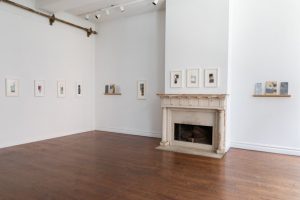Introducing Jan Cunningham, Gloria Ortiz-Hernández and Robert Szot
Extended Through February 17, 2018
Anita Rogers Gallery is thrilled to announce its 2018 Winter Group Exhibition, a collection of work by three artists new to the gallery: Jan Cunningham, Gloria Ortiz-Hernández and Robert Szot. The exhibition will be on view January 3 – February 3, 2018 at the gallery’s new location at 15 Greene Street, Ground Floor in SoHo, New York. There will be an opening reception on Wednesday, January 3, 6-8pm.
JAN CUNNINGHAM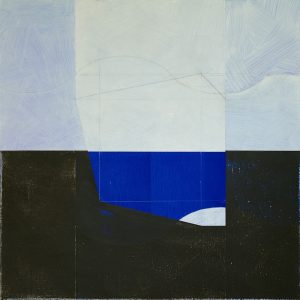
Cunningham was born in Lufkin, Texas in 1956. She received her BFA in Painting from the Rhode Island School of Design in 1979, and her MFA in Painting from the Yale University School of Art in 1985. On the work in this exhibition, Cunningham states:
The Arabesque Paintings of 2016 and 2017 evolved in response to the Arabesque Drawings of 2015 – 2016. The paintings invite the lines of the circle and the ellipse to join with a language of painting that celebrates the materiality of color and light, the juxtaposition of the anticipated with the unexpected, and the affirmation of depth by close attention to process.
Over many years, the paintings have focused on the most elemental aspects of the picture plane. On a square canvas, the dialogue between and among the dimensions of the picture plane -divided into thirds and fourths – has offered a productive way to study the mysteries of such a simple space. Recently these meditations have expanded to include the golden section rectangle, within the square and beyond it. These simple meditations I call Considerations.
Looking at the paintings becomes a matter of reseeing, of reviewing: a corner of a room in shadow; light coming in through a window; a pattern of trees silhouetted in the first light of day; the moon’s light in the surface of a lake; wonder at what might be beneath that surface. It is an experience of folding open, folding closed. Breathing in, breathing out. Resting in the depths, looking up toward the surface, through the surface of the painting.
GLORIA ORTIZ-HERNÁNDEZ
Colombian artist Gloria Ortiz-Hernández’s drawings and sculptures have been shown in numerous solo and group exhibitions. Her work is in the permanent collections of a number of institutions including The Museum of Modern Art (NY), The Fogg Art Museum at Harvard University (MA), Art Museums Cambridge (MA), The Morgan Library (NY), The Menil Drawing Institute and Study Center (TX ), and The Museum of Fine Arts, Boston (MA). Her work is also in private collections throughout the United States and in Basel, Switzerland, Sao Paolo, Brazil, and Bogota, Colombia. She currently has a drawing (Plate/Shift #10) on view at the Morgan Library and Museum in New York City.
ROBERT SZOT
Robert Szot was born in 1976 in Houston, Texas. He has exhibited his work in many galleries across the United States from New York to Los Angeles and Texas. Szot’s paintings have been exhibited in the Saatchi Gallery in London and, in 2014, the artist was invited to participate in the Whitney Museum Art Party. His work is in public collections, including Credit Suisse, and numerous private collections, such as Beth DeWoody and the Bass Family. The artist currently lives and works in Brooklyn, New York.
View on AnitaRogersGallery.com
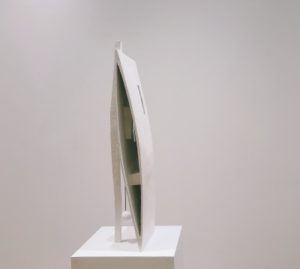 Visitors to the Lauren Rogers Museum of Art are greeted in a lobby richly decorated with golden oak paneling and cork floors. They may not notice that the ornamentation continues above, with a ceiling featuring beautiful plaster work. The design was suggested by Charles J. Watson of the Chicago interior decorating firm Watson and Walton, created by Frederick Mottas, and executed by the French-American master craftsman Léon Herman. It features low relief depictions of flora, fauna, and celestial bodies. In honor of this enchanting adornment, and in a continuation of a series of exhibitions that celebrate how artists are breathing new life into techniques and forms found in centuries-old art and design, the Museum presents this exhibition of works in plaster by contemporary artists Amy Kann, Jedediah Morfit, and Mark Webber. Their works show the effectiveness of utilizing the medium in traditional, conceptual, and abstract forms.
Visitors to the Lauren Rogers Museum of Art are greeted in a lobby richly decorated with golden oak paneling and cork floors. They may not notice that the ornamentation continues above, with a ceiling featuring beautiful plaster work. The design was suggested by Charles J. Watson of the Chicago interior decorating firm Watson and Walton, created by Frederick Mottas, and executed by the French-American master craftsman Léon Herman. It features low relief depictions of flora, fauna, and celestial bodies. In honor of this enchanting adornment, and in a continuation of a series of exhibitions that celebrate how artists are breathing new life into techniques and forms found in centuries-old art and design, the Museum presents this exhibition of works in plaster by contemporary artists Amy Kann, Jedediah Morfit, and Mark Webber. Their works show the effectiveness of utilizing the medium in traditional, conceptual, and abstract forms.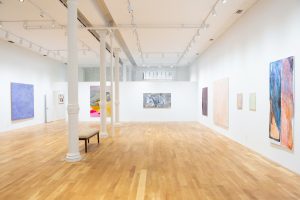
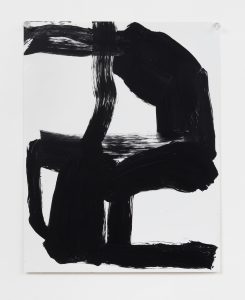

 One of the artist’s most significant works on display is a large-scale six-part canvas painting of Knossos, the largest Bronze age archaeological site in located on the Greek Island of Crete. In this painting, Rogers pulls the ancient ruins from the past into the present by using abstract designs such as the periwinkle-blue floral patterns that frame the image and bold colors including the bright and dark shades of green on the surrounding grass.
One of the artist’s most significant works on display is a large-scale six-part canvas painting of Knossos, the largest Bronze age archaeological site in located on the Greek Island of Crete. In this painting, Rogers pulls the ancient ruins from the past into the present by using abstract designs such as the periwinkle-blue floral patterns that frame the image and bold colors including the bright and dark shades of green on the surrounding grass.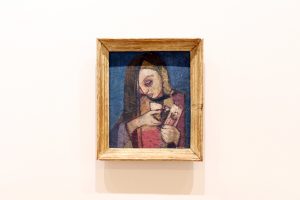 Visit the gallery’s website.
Visit the gallery’s website.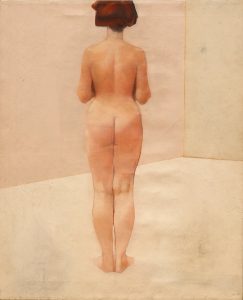 The works in the exhibition span a period of over forty years, from some of the artist’s earliest work during art school to his final masterpieces. Throughout his life, Rogers continually examined the complex notion of time and its role in the human experience. He believed forward movement and discovery are accomplished through examining history and creating relevance from the past within the present.
The works in the exhibition span a period of over forty years, from some of the artist’s earliest work during art school to his final masterpieces. Throughout his life, Rogers continually examined the complex notion of time and its role in the human experience. He believed forward movement and discovery are accomplished through examining history and creating relevance from the past within the present.